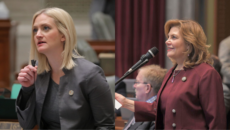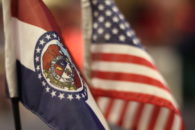American Association of University Women Calls for Legislative Action and Launches 10 Million Women Salary Negotiation Initiative to Close the Gap
WASHINGTON — An analysis by the American Association of University Women (AAUW) finds that on average women working full-time, year-round in Missouri currently make 78 cents on the dollar compared to men, a pay gap of 22 percent, placing them 30th out of all 50 states and the District of Columbia.
To mark Equal Pay Day (April 10), the symbolic day that demonstrates women, on average, have to work more than three months longer to earn the same amount as men. AAUW is highlighting The Simple Truth about the Gender Pay Gap report, which finds nationally the gap has, on average, remained at 80 cents on the dollar for women who work full-time, year-round compared to men. The gap has only closed by 7 cents in the past 20 years. The inequities are greater among Latinas (54 cents) and black women (63 cents). The pay gap also exists in every state – ranging from 30 cents in Louisiana and Utah to 11 cents in New York.
“Women in Missouri – and all over the country — are sick of unequal pay,” said Kim Churches, chief executive officer at AAUW. “That’s why we’re issuing an expiration date on pay inequity. Pay inequity harms our families and employers, while also robbing our economy of billions of dollars. There’s no reason we shouldn’t be able to close the pay gap, and do it soon. At AAUW, we’re aiming to eliminate the gap by 2030. It’s ambitious, but achievable, if we all take the right actions.”
This Equal Pay Day, AAUW calls for every state to adopt comprehensive equal pay laws. While 48 states and the District of Columbia (all except Alabama and Mississippi) have some form of an equal pay law, they differ significantly in their scope and strength. Currently, Missouri has poor equal pay protections in place. A comprehensive breakdown of strong pay equity laws is available at https://www.aauw.org/resource/state-equal-pay-laws/.
| Missouri Equal Pay Policy Snapshot | ||
| A strong equal pay law includes many provisions. This chart provides a snapshot of just three important policies. For a comprehensive overview of current equal pay laws click here. | ||
| A “Y” means state has particular policy | ||
| Best Practices | Missouri Law | National Trends (States + Washington, D.C.) |
| Employers are prohibited from discriminating or retaliating against an individual for taking legal action to secure equal pay. | 41 states | |
| Employers are prohibited from discriminating or retaliating against an individual for discussing or disclosing wages. | 19 states | |
| Employers cannot rely on salary history during the hiring process. | 4 states | |
For a complete breakdown of Missouri’s current equal pay laws, visit: https://www.aauw.org/aauw_check/pdf_download/show_pdf.php?file=Gender_Pay_Gap_Missouri
So far in 2018, 38 states and the District of Columbia have introduced or have some form of equal pay legislation pending. In 2016, six states passed pay equity laws (California, Delaware, Maryland, Massachusetts, Nevada, and Utah), and in 2017, five states and Puerto Rico passed laws (California, Colorado, Delaware, Nevada, and Oregon).
The Missouri General Assembly submitted numerous equal pay bills, but none have progressed since their introductions. If this inaction continues, the legislature will again show that they are unwilling to work to make the lives of women better and more equitable. In addition to state action, AAUW is calling for:
- The federal government to reinstate the EEOC’s wage data collection, which was halted last year by the U.S. Office of Management and Budget. Collecting wage data information is critical in order to identify and address gender and racial pay gaps in workplaces.
- Congress to pass the Paycheck Fairness Act, to update and close loopholes in in the Equal Pay Act of 1963, as well as to pass other pieces of federal legislation that provide additional tools to close the wage gap.
- Employers to commit to and implement fair pay best practices, such as conducting regular compensation analyses to ensure equal pay levels and internal equity, setting and publicizing pay ranges for positions, prohibiting the practice of asking job candidates for salary histories, which perpetuates a cycle of lower pay for women, adopting non-retaliation policies for discussing salary, and promoting more women into leadership roles.
AAUW has also announced a new commitment to train 10 million women through salary negotiations programs by 2022 through AAUW’s Work Smart program. The trainings will provide millions of women the skills they need to effectively understand their market worth — based on skills, experience, and accomplishments — and the tools and confidence to negotiate for it. The organization has launched an e-learning interactive experience, It’s Negotiable: Salary Skill Builder, in partnership with LUNA® Bar, the first nutrition bar for women. The skill builder focuses on helping individuals learn to identify and articulate personal value as one key aspect of negotiations. Through April 14, as a continued effort to champion equality for all women and help them move toward closing the gender pay gap, LUNA Bar will donate 20 percent of sales, up to $100,000, to support AAUW’s salary negotiation programs.
“Training 10 million women to speak up for themselves – and to understand and articulate their value — will help accelerate change for women individually while also, collectively, building a bigger, broader movement to even the playing field for women in the workplace,” Churches added. “We are calling on mayors and governors across the country to join us and bring salary negotiation trainings to their communities.”
AAUW’s Work Smart has already partnered with Boston, Tempe, San Francisco, Washington, D.C., Long Beach, and the Commonwealth of Massachusetts to provide workshops in those communities. And in fall 2018, AAUW’s Work Smart will be available online, which will be available at no cost and in English and Spanish.
“While some progress has been made to narrow the pay gap, we know there’s more work to do – especially for women of color who are still paid far less than men for the same work,” said Wendy Doyle, Women’s Foundation president & CEO. “We commend AAUW for their commitment to closing the pay gap and look forward to working with them to empower women and promote economic opportunity throughout the region. Women and their families simply cannot afford wait decades for the pay gap to close – and with a sustained effort by all of us, they won’t have to.”
Research has shown that the U.S. economy would produce additional income of more than $512.6 billion if women received equal pay and the number of working women living in poverty in half. A recent analysis by McKinsey found that $12 trillion could be added to the global GDP by 2025 with better workplace gender equity practices.
More information about AAUW’s salary negotiation workshops, including upcoming workshops and how to host a training, is available at: https://salary.aauw.org/. More information on the gender pay gap and pay equity laws is available at: www.aauw.org.
PAY GAP BY STATE
2016 state median annual earnings ratio for full-time, year-round workers, by state and gender ranked from smallest to largest pay gap. State pay gaps are displayed rounded to the nearest whole percentage, but are ranked by unrounded percentage.
- New York, 89%| 2. California, 88%| 3. Florida, 87% |4. District of Columbia, 86%| 5. Vermont, 86%| 6. Colorado, 84%| 7. Alaska, 84%| 8. Maine, 84%| 9. Maryland, 84%| 10. Hawaii, 83%| 11. New Hampshire, 83%| 12. Minnesota, 83%| 13. Tennessee, 82%| 14. Massachusetts, 82%| 15. Delaware, 82%| 16. New Mexico, 82%| 17. Georgia, 82%| 18. North Carolina, 82%| 19. Arizona, 82%| 20. Rhode Island, 82%| 21. New Jersey, 81%| 22. Nevada. 81%|United States, 80%| 23. Virginia, 80%| 24. Kentucky, 80%| 25. Connecticut, 79%| 26. Texas, 79%| 27. Oregon, 79%| 28. Illinois 79%| 29. Pennsylvania, 79%| 30. Missouri, 78%| 31. Arkansas, 78%|32. Michigan, 78%|33. Wisconsin, 78%|34. South Dakota, 78%|35. South Carolina, 78%|36. Nebraska, 78%|37. Kansas, 77%|38. Ohio, 77%|39. Wyoming, 77%|40. Washington, 77%|41. Iowa, 77%|42. Idaho, 76%|43. Mississippi, 75%|44. Alabama, 74%|45. North Dakota, 74%|46. Indiana, 74%|47. Oklahoma, 74%|48. Montana, 73%|49. West Virginia, 72%|50. Utah, 70%|51. Louisiana, 70%
###
The American Association of University Women (AAUW) empowers women and girls through advocacy, education, philanthropy, and research. Our nonpartisan, nonprofit organization has more than 170,000 members and supporters across the United States, as well as 1,000 local branches and 800 college and university members. Since AAUW’s founding in 1881, our members have examined and taken positions on the fundamental issues of the day — educational, social, economic, and political. Learn more and join us at www.aauw.org.
This email was sent to travis@themissouritimes.com
American Association of University Women, 1301 L Street NW, Washington, District of Columbia 20005, United States
Unsubscribe









